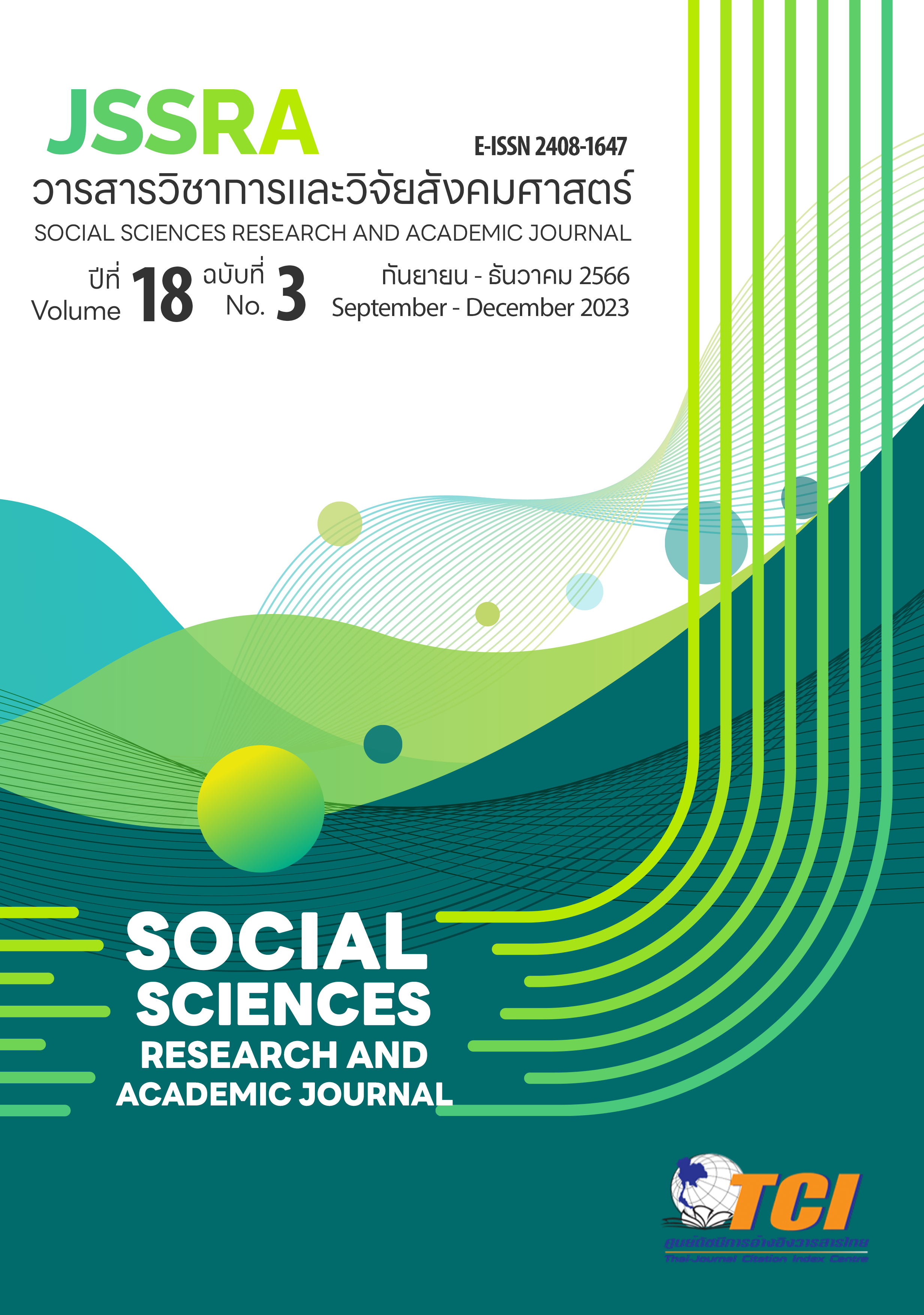อิทธิพลของการรับรู้ความเสี่ยงต่อการตัดสินใจซื้อสินค้าออนไลน์จากธุรกิจขนาดย่อมของผู้บริโภคในเขตกรุงเทพมหานคร Influence of Consumer Perceived Risk on Online Shopping Decisions from Small Businesses in Bangkok
Main Article Content
Abstract
The objectives of this research were 1) to study consumers' perceived risk of puying online products from small businesses; 2) to study consumers' decision to buy online products from small businesses; 3) Study the relationship between perceived risk of online shopping decisions from small businesses. and 4) Create a forecasting equation for risk perception that influences consumers' decision to buy online products from small businesses in Bangkok. The sample group is 385 consumers in Bangkok who have experienced online shopping from small businesses. The tools used for data collection were item survey questionnaires and 5-level estimating scales, divided into 3 sections. Statistics used in data analysis were frequency, percentage, mean, and standard deviation. Pearson correlation coefficient and multiple regression analysis.
From the research, it was found that 1) Consumers' perceived risk of buying online products from small businesses 2) Studying consumer's decision to buy online products from small businesses whole were at a high level 3) Puying decision online products from small businesses of consumers whole were at a high level was found to have a positive correlation statistically significant at the 0.01 level. 4) The results of a study of risk perception influencing consumers' decision to buy online products from small businesses in Bangkok. There were 6 variables with statistical significance at the 0.05 level, which can be sorted in descending order as follows: safety risks, financial risk, psychological risk, outcome risk, social risk and opportunity/time risk Accordingly, the forecasting equations can be written in the form of raw scores and standard scores, respectively, as follows:
= 0.020+0.330(X6)+0.218(X2)+0.139(X4)+0.117(X1)+0.099(X3)+0.086(X5)
2Ŷ= 0.365(X6)+0.242(X2)+0.153(X4)+0.143(X1)+0.105(X3)+0.078(X5)
Article Details
References
กรมพัฒนาธุรกิจการค้า กองพาณิชย์อิเล็กทรอนิกส์ กระทรวงพาณิชย์. (2564). ธุรกิจ Social Commerce, สืบค้นเมื่อ 20 กรกฎาคม 2566, จาก https://www.dbd.go.th/news_view.php?nid=469416588
กิจติวัฒน์ รัตนมณี และกฤชคุณ ผาณิตญาณกร. (2565). การรับรู้และการจัดการความเสี่ยงในการซื้ออาหารผ่านช่องทางออนไลน์ของผู้บริโภคในเขตกรุงเทพมหานคร ภายใต้สถานการณ์การแพร่ระบาดของโควิด-19, วารสารสหวิทยาการสังคมศาสตร์และการสื่อสาร, 5(3), 171-179. https://doi.org/10.14456/issc.2022.16
กิตติพันธ์ คงสวัสดิ์เกียรติ, ณัฏฐ์ชัย สิริธนธานี และภัคสิริกาญจน์ สิริธนธานี. (2560). การจัดการความเสี่ยงและตราสารอนุพันธ์. กรุงเทพฯ: เพียร์สัน เอ็ดดูเคชั่น อินโดไชน่า.
ฐิติพร เฟื่องวรรธนะ. (2558). การรับรู้และการจัดการความเสี่ยงในการซื้อผลิตภัณฑ์จากร้านค้า บนเครือข่ายสังคมออนไลน์ของผู้บริโภคในเขตกรุงเทพมหานคร. สารนิพนธ์บริหารธุรกิจมหาบัณฑิต (การจัดการ). มหาวิทยาลัยศรีนครินทรวิโรฒ: กรุงเทพฯ.
ธมลวรรณ สมพงศ์และ ประจวบ กล่อมจิตร. (2564). การศึกษาปัจจัยที่มีผลต่อการตัดสินใจซื้อสินค้าทางออนไลน์ของผู้บริโภคในจังหวัดนครปฐม. การประชุมนำเสนอผลงานวิจัยบัณฑิตศึกษาระดับชาติ บัณฑิตวิทยาลัย มหาวิทยาลัยรังสิต ครั้งที่ 16 ปี การศึกษา 2564.
พุฒิพงศ์ เอี่ยมสินธร. (2561). เอกสารประกอบการสอนวิชาระเบียบวิธีวิจัยธุรกิจ. กรุงเทพฯ: สาขาการจัดการ คณะบริหารธุรกิจ, มหาวิทยาลัยรัตนบัณฑิต.
วรวีร์ เธียรธนเกียรติ. (2564). การรับรู้ประโยชน์ของการช้อปปิ้งออนไลน์ การรับรู้ความสี่ยง ความไว้วางใจและการตัดสินใจซื้อสินค้าอิเล็กทรอนิกส์ผ่านเว็ปไซต์อิเล็กทรอนิกส์. วารสารการสื่อสารและการจัดการนิด้า, 3(1), 64-78.
ศิริลักษณ์ โรจนกิจอำนวย. (2561). การรับรู้ความเสี่ยงและความไว้วางใจที่ส่งผลต่อการซื้อผ่านพาณิชย์อิเล็กทรอนิกส์ ข้ามพรมแดน. วารสารจุฬาลงกรณ์ธุรกิจปริทัศน์, 40 (157), 79-99.
Boshoff, C., Schlechter, C. & Ward, S. J. (2011). Consumers’ Perceived risks associated with purchasing on a branded website: The mediating effect of brand knowledge. South African Journal of Business Management, 42(1), 45-54.
Cochran. (1953). Evaluating structural equation models with unobservable variables and measurement. error. Journal of Marketing Research, 18(1), 39-50
Cronbach. (1990). Essentials of psychological testing (5th ed.). New York: Harper Collins. Publishers. (pp.202-204)
Forsythe, S.M. and Shi, B. (2003). Consumer Patronage and Risk Perceptions in Internet Shopping. Journal of Business Research, 56, 867-875. http://dx.doi.org/10.1016/S0148-2963(01)00273-9.
Goolsbee and Klenow. (2013). Goodness-of-fit indices for partial least squares path modeling. Computational Statistics, 28(2), 565-580.
Likert & Rensis. (1967). The Method of Constructing and Attitude Scale. In Reading in Fishbeic, M (Ed.), Attitude Theory and Measurement (pp. 90-95). New York: Wiley & Son.
Rovinelli, R. J., & Hambleton, R. K. (1997). On the use of content specialists in the assessment of criterion-referenced test item validity. Dutch Journal of Educational Research. 2, 49-60.
Schlechter & Ward, (2011). An integrative model of organizational trust. The Academy of Management Review, 20(3), 709-734.
Zheng et al. (2012). Connecting with consumer. United Kingdom: Oxford University Press.


